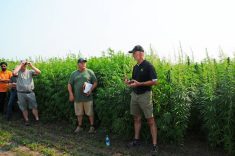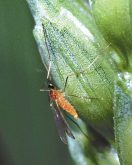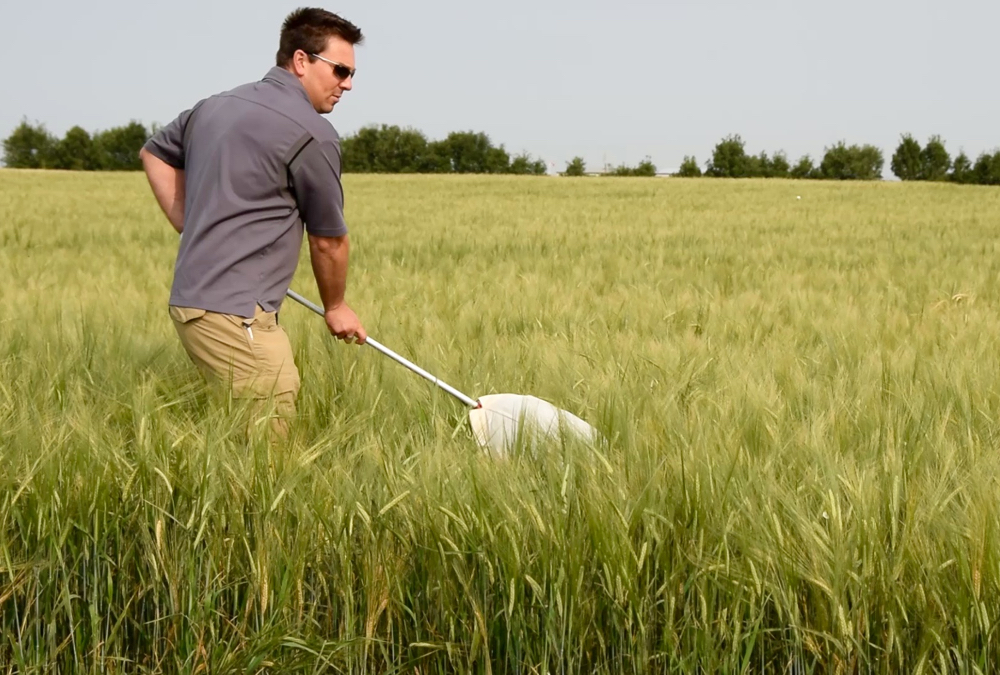A new public-academic research project is scrutinizing an older spring wheat variety to assess its potential for midge tolerance.
Researchers with Agriculture and Agri-Food Canada and the University of Manitoba are genomically mapping the 2013-released AC Vesper VB spring wheat to understand a trait that appears to repel female wheat midge from laying eggs on the plant.
“(It) seemed to have a different form of oviposition deterrence — which is egg laying deterrence — than other wheat did,” said lead researcher Tyler Wist, who works in the AAFC Saskatoon Research and Development Centre.
Read Also

Hail research hopes to benefit potato growers
Alberta research scientist measures hail storm and heat dome affects on potato crops
“It matched to a different area on the chromosomes, basically.”
The team involved in the “Enhanced surveys, wheat resistance traits and midge genetic variation to preserve the Sm1 gene” project (or, as Wist likes to call them, the Midgebusters) planted a population of Vesper crosses and sent them to AAFC Brandon, where they’re being qualified for midge-deterring traits.
Sm1 is the gene that drives midge tolerance in spring wheat.
If Vesper passes the deterrence test, the next challenge is breeding its traits into a modern spring wheat with today’s expectations.
“Our AAFC wheat breeders would cross-breed so that we get that region that we want — that region that seems to do something interesting against wheat midge — and then cross-breed it into modern wheat that’s got disease resistance and good standability, doesn’t lodge and has Sm1.”
The overarching project is designed to genetically map wheat varieties for midge tolerant traits and develop an understanding of egg-laying deterrence on wheat.
The research is timely because of higher wheat midge pressure this year compared to recent years, said Wist.
A major focus is on extending and expanding the life of the Sm1 midge-resistance gene. The first midge tolerant wheat variety came out 14 years ago, but varieties since then continue to depend on this gene.
The team wants to discover new resistant genes and traits in order to stack them into new varieties, extending the life of Sm1 in the process.
“It’s a single resistance gene and so, if we lose it, then we’re back to spraying. And there’s only one chemical left that’s registered for spraying against wheat midge (dimethoate) and it only kills adults.”
Work in the field
The project involves 150 midge traps set up across Alberta, Saskatchewan and Manitoba, baited with female midge pheromones. To date, the traps have captured 38,200 male midges.
That sub-project aims to find a correlation between the pheromone-based method of trapping male midges and the instances of females laying eggs in wheat plants in the field.
“We’re trying to match the pheromone trapping to the emergence of larvae in the heads because, of course, on the pheromone trap, we’re catching males and males don’t lay eggs,” said Wist.
“If we can get some kind of a good correlation between the males that are emerging and we’re catching on traps and actual damage and larval attack in the field, then we’ll have a better idea about what these pheromone traps mean.”
Current scouting knowledge does not have a good guideline for how many plant heads a producer should collect for a representative sample. Researchers are working on that number.
“What my technicians have been doing is dissecting the heads in groups of 10 so that we can say, ‘OK, does this group of 10, does it accurately reflect what we got when we dissected 200?’…(We’re) trying to figure out that best sample size that works for farmers, that works for agronomists and that works for us as scientists, because dissecting 200 heads takes a lot of time.”
Female midges emerge soon after males. Once the males are out, it’s time to start watching the crop.
“The crop staging that’s most susceptible to wheat midge is … as soon as the boot splits up (or as soon as the wheat spike is visible) until the mid-flowering. Then susceptibility drops right off and the larvae don’t do very well after that point,” said Wist.
Gene by gene
Evaluating other genes with suspected midge tolerance traits is another component of the project. One such gene, the egg antibiosis resistance gene, appears to kill wheat midge eggs.
The researchers’ work substantiates that suspicion, but the gene helped the plant kill the insects at a different stage than expected.
“The data looked really convincing, but what we actually wound up finding was that the eggs were laid and the eggs did hatch, but that the larvae died really quickly on those heads,” Wist said.
This effect only occurred if the Sm1 tolerance gene was present along with the egg antibiosis gene.
“Some of the crops that we produced (under the project) had zero wheat midge damage. And then the checks had almost 50 per cent seeds damaged. So the real big difference … is between the ones with these two genes and ones without any genes.”
Mechanical control
Team members investigated mechanical resistance traits in parts of the wheat plant, such as glumes and awns.
A glume is the covering that goes over the seed and covers the spikelet. Glumes with hair on them initially appeared to change the egg-laying behaviour of the female wheat midge, said Wist.
“And so, instead of putting her eggs underneath the glumes, she was actually putting them on top of the glumes, because I don’t think she could get underneath the glumes with all of the little spikes that were on there.”
However, hairy glumes did not reduce kernel damage.
“Probably what was going on there was the midge larvae were maneuverable enough that they could get themselves … under the wheat kernel and still cause their wheat midge damage. So that was unfortunate.”
An experiment with the awns of wheat plants also revealed few midge-repelling effects.
“Most wheat has awns, but there’s some evidence that awns will stop flying insects or deter flying insects from landing on the plant,” said Wist.
“So we were trying to evaluate that with wheat midge as well, and it didn’t have much of an effect itself, but even a small effect is better than nothing, especially if awns are already on most of the wheat that we’ve got in our cropping area anyway.”
This research is part of a co-operative project between scientists from Agriculture and Agri-Food Canada research centres in Swift Current, Brandon and Morden, as well as the University of Manitoba. It’s funded by the Sustainable Canadian Agricultural Partnership.
















